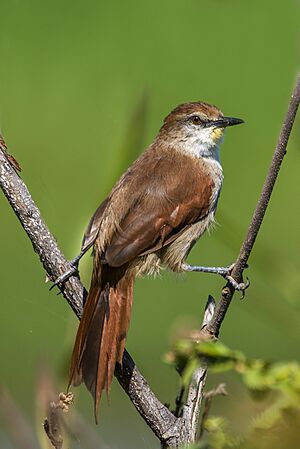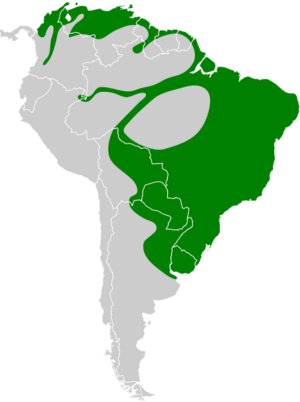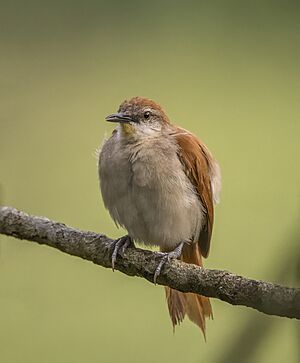Yellow-chinned spinetail facts for kids
Quick facts for kids Yellow-chinned spinetail |
|
|---|---|
 |
|
| In Brazil. Note spiny tail feathers. |
|
| Conservation status | |
| Scientific classification | |
| Genus: |
Certhiaxis
|
| Species: |
cinnamomeus
|
 |
|
| Synonyms | |
|
Certhiaxis cinnamomea (lapsus) |
|
The yellow-chinned spinetail (Certhiaxis cinnamomeus) is a small bird known as a passerine. This means it's a type of songbird. You can find these birds in the warm, tropical parts of the New World. This includes places like Trinidad and Colombia, all the way south to Argentina and Uruguay. It belongs to the family of South American ovenbirds, called Furnariidae.
Contents
About the Yellow-chinned Spinetail
This section will tell you more about what makes the yellow-chinned spinetail special. We will look at its name, how it looks, and where it lives.
Naming the Yellow-chinned Spinetail
The yellow-chinned spinetail got its official name in 1788. A German scientist named Johann Friedrich Gmelin gave it the scientific name Certhia cinnamomea. The word cinnamomeus means "cinnamon-coloured" in Latin. This name describes the bird's reddish-brown feathers.
Today, this bird is placed in a group called Certhiaxis. This group also includes its relative, the red-and-white spinetail. Scientists study these names to understand how different birds are related.
What Does the Spinetail Look Like?
The yellow-chinned spinetail is about 15 centimeters (6 inches) long. It weighs around 15 grams, which is about as much as three nickels. It is a thin bird with a long tail. The feathers on its back and head are a warm chestnut brown. Its belly is whitish, but its throat is a pale yellow. This yellow patch gives the bird its name.
Both male and female spinetails look very similar. However, there are different types, or subspecies, of this bird. These types might have slightly different colours on their heads or bodies. When this bird calls, it makes a loud, rattling sound.
Where the Spinetail Lives and What it Does
The yellow-chinned spinetail lives in many parts of South America. It is very common in Brazil, especially along the coast and near big rivers. You can also find it in countries like Venezuela, Colombia, Bolivia, Argentina, Paraguay, and Uruguay.
Spinetail Homes and Habitats
This bird loves to live in marshes and the edges of mangrove swamps. These are wet, watery areas with lots of plants. It also likes open woodlands close to rivers. It is a common bird in these areas.
What the Spinetail Eats
The yellow-chinned spinetail mostly eats insects and spiders. It stays low to the ground while looking for food. It is often easy to spot because it is not shy and can be quite noisy.
Building Nests and Raising Chicks
Unlike some other ovenbirds, the yellow-chinned spinetail builds a big, round nest out of sticks. It usually places its nest low down in a mangrove tree or other marsh plants. The nest has a special entrance. This entrance is a tube that goes almost straight up from the bottom of the nest to the top.
A female spinetail usually lays three eggs, but sometimes four. The eggs are a greenish-white colour.
Other Birds and the Spinetail Nest
Sometimes, another bird called the striped cuckoo (Tapera naevia) will use the spinetail's nest. The cuckoo lays one or two of its own eggs in the spinetail's nest. Scientists are still learning how the cuckoo gets its eggs into the nest. They also wonder if the cuckoo's chicks push out the spinetail's own young.
Is the Spinetail in Danger?
The yellow-chinned spinetail lives in a very large area. Because there are so many of them, scientists do not think this bird is in danger. The IUCN (International Union for Conservation of Nature) says it is a species of "least concern." This means it is not currently threatened.



